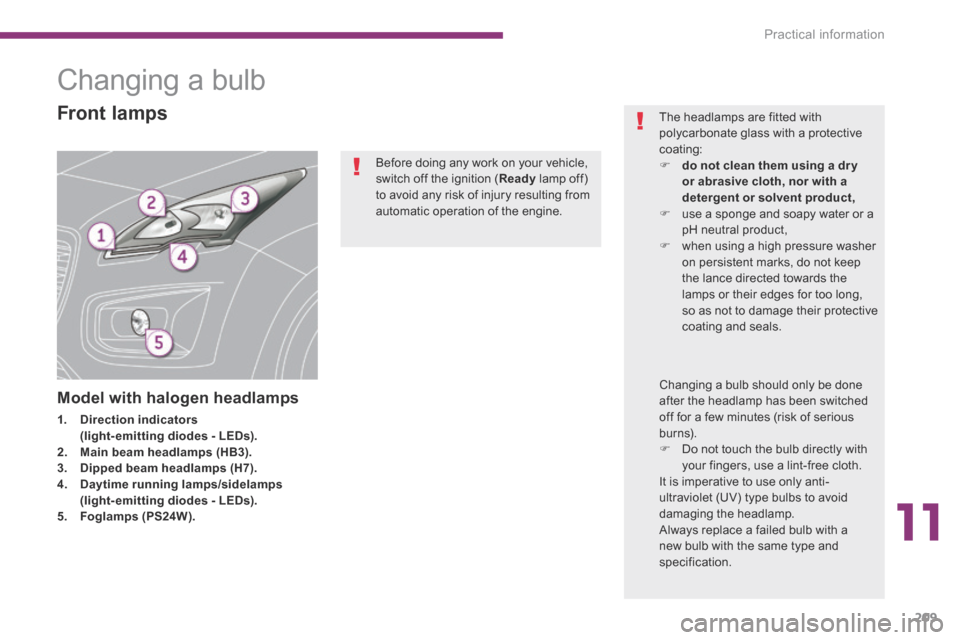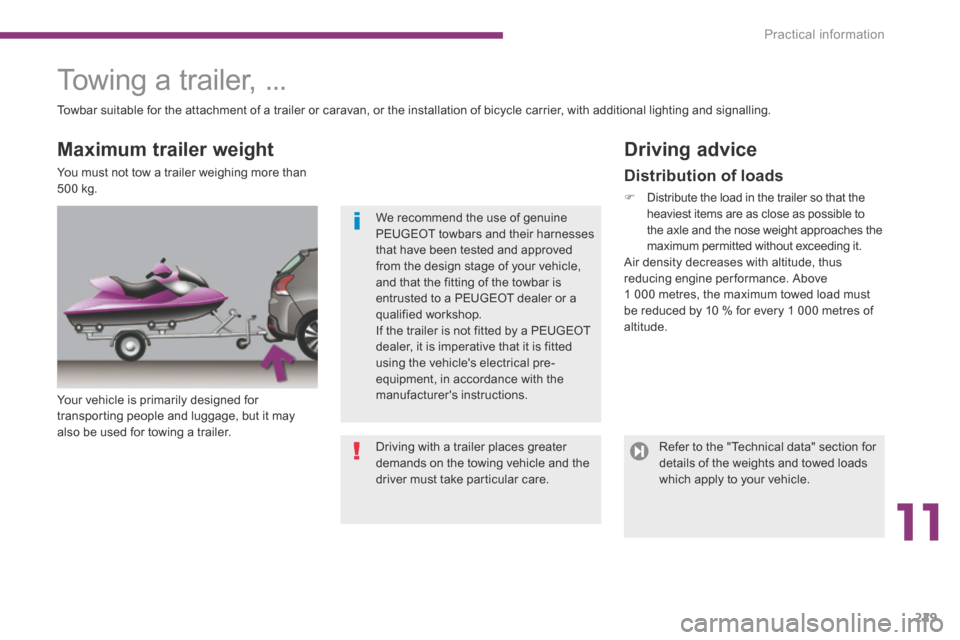Page 206 of 378
Practical information
204
Other accessories
7. Removable towing eye.
* According to country of sale.
See "Towing the vehicle".
List of tools
All of these tools are specific to your vehicle. Do not use them for other purposes. 1. Wheelbrace. * For removing the wheel fixing bolts. 2. Jack with integral handle. * For raising the vehicle.
3a. Wheel trim removal tool (depending on equipment) * . For removing the central wheel trim on alloy wheels. 3b. Wheel bolt finisher removal tool (depending on equipment) * . For removing the bolt head finishers on alloy wheels. 4. Centre guide * . For refitting an alloy wheel to the hub. 5. Socket for the security bolts (located in the glove box) * . For adapting the wheelbrace to the special "security" bolts. 6. Chocks to immobilise the vehicle (depending on equipment).
Page 209 of 378
11
Practical information207
List of operations
Put the wheel in place on the hub. Screw in the bolts by hand to the stop. Pre-tighten the security bolt (if your vehicle has them) using the wheelbrace 1 fitted with the security socket 5 . Pre-tighten the other bolts using the wheelbrace 1 o n l y.
Lower the vehicle fully. Fold the jack 2 and detach it. Tighten the security bolt (if your vehicle has them) using the wheelbrace 1 fitted with the security socket 5 . Tighten the other bolts using the wheelbrace 1 o n l y. Refit the central wheel trim then press to clip it in place, or refit the bolt covers to each bolt. Stow the tools.
Page 211 of 378

11
Practical information209
Changing a bulb
Model with halogen headlamps
1. Direction indicators (light-emitting diodes - LEDs).2. Main beam headlamps (HB3).3. Dipped beam headlamps (H7).4. Daytime running lamps/sidelamps (light-emitting diodes - LEDs).5. Foglamps (PS24W).
Front lamps
Before doing any work on your vehicle, switch off the ignition ( Ready lamp off) to avoid any risk of injury resulting from automatic operation of the engine.
The headlamps are fitted with polycarbonate glass with a protective coating: do not clean them using a dr y or abrasive cloth, nor with a detergent or solvent product, use a sponge and soapy water or a pH neutral product, when using a high pressure washer on persistent marks, do not keep the lance directed towards the lamps or their edges for too long, so as not to damage their protective coating and seals.
Changing a bulb should only be done after the headlamp has been switched off for a few minutes (risk of serious burns). Do not touch the bulb directly with your fingers, use a lint-free cloth. It is imperative to use only anti-ultraviolet (UV) type bulbs to avoid damaging the headlamp. Always replace a failed bulb with a
new bulb with the same type and specification.
Page 213 of 378
11
Practical information211
Changing foglamp bulbs
Contact a PEUGEOT dealer or a qualified workshop. Insert a screwdriver towards the centre of the repeater between the repeater and the base of the mirror. Tilt the screwdriver to extract the repeater and remove it. Disconnect the repeater connector.
Changing integrated direction indicator side repeaters
You can also contact a PEUGEOT dealer or a qualified workshop to have these lamps changed.
To refit, carry out these operations in reverse o r d e r. Contact a PEUGEOT dealer or a qualified workshop to obtain a new repeater.
Page 229 of 378
11
Practical information227
From the front Access to the tools
The towing eye is installed in the boot under the floor. To gain access to it: open the boot,
raise the floor, remove the towing eye from the holder.
From the rear
Recovering the vehicle on a fl at-bed
Procedure for having your vehicle recovered on a flat bed lorry or trailer.
On the front bumper, unclip the cover by pressing at the bottom. Screw the towing eye in fully.
On the rear bumper, unclip the cover by pressing at the bottom. Screw the towing eye in fully. Switch on the hazard warning lamps on the recovered vehicle.
Always recover the vehicle on a flat bed lorr y or trailer. Never tow the vehicle with the four wheels on the ground (or the front or rear wheels only), you risk damaging the transmission. Place the gear selector in position N and switch off the engine ( Ready lamp off).
Page 230 of 378
Practical information
228
Vehicle recover y
Before doing any work, with the ignition on, press the brake pedal and put the gear selector to position N , then switch off the hybrid system. If necessary because access to the vehicle is difficult, it can be moved a few dozen metres at a speed not exceeding 6 mph (10 km/h).
The front or rear wheels must not be on the ground, use a flat-bed lorry or trailer to recover the vehicle.
Use the towing eyes only to pull a vehicle out or to pull it onto a flat-bed.
Page 231 of 378

11
Practical information229
Towing a trailer, ...
Your vehicle is primarily designed for transporting people and luggage, but it may also be used for towing a trailer.
Driving advice Maximum trailer weight
You must not tow a trailer weighing more than 500 kg. Distribution of loads
Distribute the load in the trailer so that the heaviest items are as close as possible to the axle and the nose weight approaches the maximum permitted without exceeding it. Air density decreases with altitude, thus reducing engine performance. Above 1 000 metres, the maximum towed load must be reduced by 10 % for every 1 000 metres of altitude.
Towbar suitable for the attachment of a trailer or caravan, or the installation of bicycle carrier, with additional lighting and signalling.
Driving with a trailer places greater demands on the towing vehicle and the driver must take particular care.
We recommend the use of genuine
PEUGEOT towbars and their harnesses that have been tested and approved from the design stage of your vehicle, and that the fitting of the towbar is entrusted to a PEUGEOT dealer or a qualified workshop. If the trailer is not fitted by a PEUGEOT dealer, it is imperative that it is fitted using the vehicle's electrical pre-equipment, in accordance with the manufacturer's instructions.
Refer to the "Technical data" section for details of the weights and towed loads which apply to your vehicle.
Page 232 of 378
Practical information
230
Cooling
Towing a trailer on a slope increases the temperature of the coolant. As the fan is electrically controlled, its cooling capacity is not dependent on the engine speed. To lower the engine speed, reduce your speed. The maximum towed load on a long incline depends on the gradient and the ambient temperature. In all cases, keep a check on the coolant temperature.
Side wind
Take into account the increased sensitivity to side wind.
Ty r e s
Check the tyre pressures of the towing vehicle and of the trailer, observing the recommended pressures.
Braking
Towing a trailer increases the braking distance.
If the warning lamp and the STOP warning lamp come on, stop the vehicle and switch off the engine as soon as possible.
Lighting
Check the electrical lighting and signalling on the trailer.
The rear parking sensors will be deactivated automatically if a genuine PEUGEOT towbar is used.